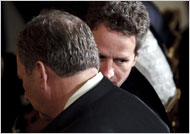DETROIT — With its access to a government lifeline possibly at risk, General Motors executives were locked in intense negotiations Monday with leaders of the United Automobile Workers over ways to cut its vast bills for retiree health care.

Nick Smaljlaj, left, with the help of Mario Curanaj, looks at vehicles at Zanetti Chrysler Jeep Dodge in the Bronx.
G.M. will file what is expected to be the largest restructuring plan of its 100-year history on Tuesday, a step it must take to justify its use of a $13.4 billion loan package from the federal government.
The plan will outline in considerable detail, over as many as 900 pages, how G.M. will further cut its work force, shutter more factories in North America and reduce its lineup of brands to just four, from eight, according to executives knowledgeable about its contents. The remaining core brands will be Chevrolet, Cadillac, GMC and Buick.
But G.M.’s plan to shrink its way to profitability will not mean much without an agreement with the U.A.W.
On Monday, G.M. pressed union leaders in a meeting in Detroit for a deal on financing what was the centerpiece of the 2007 U.A.W. contract — a perpetual, G.M.-financed trust to cover health care costs of hundreds of thousands of retired hourly workers and their surviving spouses.
Both sides were hopeful that either an agreement, or at least significant progress, might be achieved by the time G.M. submitted its plan, according to three people familiar with the substance of the negotiations.
Talks are also continuing between the U.A.W. and Ford Motor and Chrysler. But the focus of negotiations has been with G.M., which has to address how a company that lost more than $20 billion last year can afford $5 billion a year in medical bills.
In its overall plan, G.M. needs to show President Obama’s new cabinet-level task force that it can substantially reduce costs and make a convincing case about its long-term viability by a March 31 deadline.
The company has already extended buyout offers to its entire United States unionized work force to reduce their ranks by another 20,000 jobs. It has also announced a 14 percent reduction in salaried workers around the world, leaving many of its white-collar workers in Detroit with limited prospects.
The plan will also probably include revisions in executive compensation and targets for cutting dealers and brands like Saturn and Pontiac.
Details of the plan have been closely guarded. G.M.’s board met Monday to review its contents, which will not be completed possibly until Tuesday, according to one G.M. official who asked not to be identified because of confidentiality agreements.
Chrysler was also said to be in the final stages of completing its plan on Monday, which will include further cuts in its manufacturing operations in the United States and more details on its strategy to rebuild its product lineup with a network of foreign alliances.
The plan was still under discussion late Monday with officials at Cerberus Capital Management, owner of an 80 percent stake, according to a person with knowledge of the situation.
The White House press secretary said Monday that the Obama administration was “anxious” to see the plans, but shared no timetable on when the president’s task force would comment.
“We’re anxious to take a look at the plans, understanding that it is extremely important to have a strong and viable auto industry,” the press secretary, Robert Gibbs, told reporters aboard Air Force One. “Obviously that is going to require some restructuring to ensure its viability.”
On Monday, the president designated the Treasury secretary, Timothy F. Geithner, and the chairman of the National Economic Council, Lawrence H. Summers, to oversee the task force on the auto industry.
The move surprised executives at G.M. and Chrysler, who were expecting the appointment of a “car czar” who would play an active part in negotiations between G.M. and Chrysler and their unions and lenders.
The task force is not likely to complete any review of the plans for at least a week or 10 days, according to an administration official who spoke on condition of anonymity. The president expects negotiations between G.M. and the U.A.W. and others to continue without pause for the plan’s submission, the official said.
Talks between G.M. and its bondholders have cooled while the automaker considers the framework of an agreement offered by the bondholders to reduce G.M.’s debt to $9 billion, from $28 billion.
The U.A.W. talks, however, have been constant since Saturday, when Ron Gettelfinger, the union’s president, at one point cut off discussions with G.M. — only to drive across town to take up the topic of retiree health care with Ford.
Ford has not received government loans, so it is significant that the U.A.W. appears to believe it must address retiree health care at all three Detroit auto companies simultaneously.
G.M. has the most at stake with the U.A.W. Its future obligations for retiree health care are estimated at $47 billion, and by next year it is required by its contract to contribute more than $10 billion to the trust set up in 2007.
The company, which nearly ran out of money before receiving the first $9.4 billion of its $13.4 billion in late December, is pressing the U.A.W. to accept stock for as much as 50 percent of its next contribution to the trust, according to two people knowledgeable about the discussions.
Mr. Gettelfinger, for his part, is trying to protect one of the jewels of the U.A.W. contract, which is essentially health care for life for anyone who worked on the assembly line and their surviving spouses. G.M. has already canceled health care for more than 100,000 of its salaried retirees.
“The U.A.W. at this point understands that it can very well turn into the villain of this whole thing by insisting that its workers receive health care benefits that few workers do,” said Gary N. Chaison, a labor expert at Clark University in Worcester, Mass.
U.A.W. members are bracing for bad news, and worrying that their health care plan will be sacrificed to keep G.M. from going bankrupt.
“Where does it all stop?” said Mike Green, president of U.A.W. Local No. 652, which represents workers in Lansing, Mich. “It would be devastating. Our typical person works between 30 and 40 years. They did their part. Why should they have it taken away with the sweep of a pen?”














